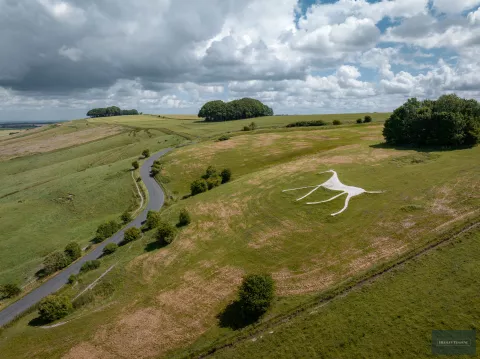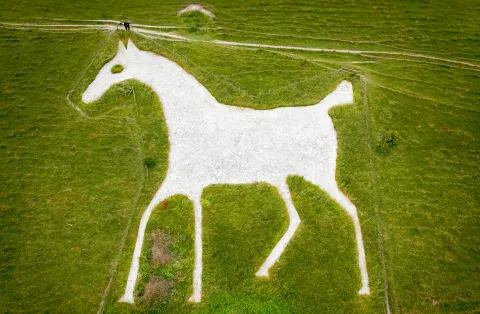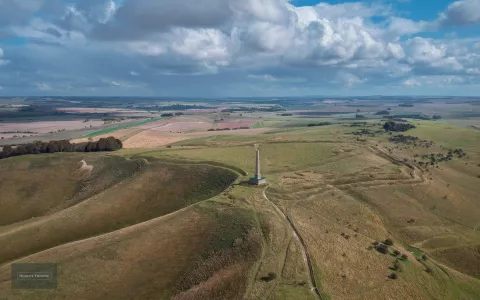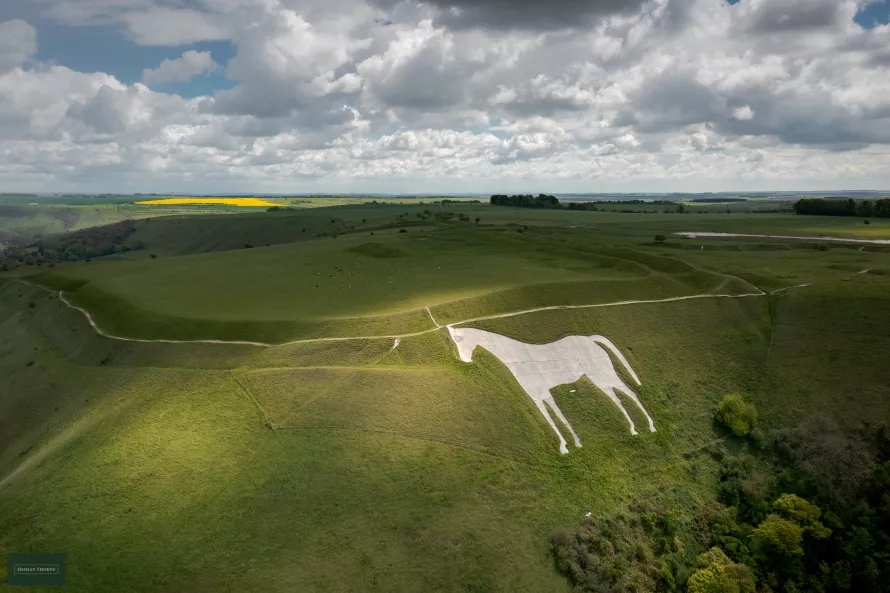The Uffington White Horse is unique because of its age, its abstract flowing shape and the fact that it has survived. Depending on a number of factors, such as weather and land-use, the Horse would probably become overgrown, and virtually disappear after about a decade of neglect. Strictly speaking this need not be the end of the Horse. Because it is made of a chalk-filled trench construction archaeologists could re-locate it, in the same way they can find the post-holes and ditches of prehistoric houses. It is very doubtful that this would have happened in the past.
We do know that some hill-figures have disappeared, notably the Red Horse of Tysoe in Northamptonshire and the Tan Hill (Wilts) Horse and geoglyphs on the Gog-Magog Hills in Cambridgeshire.

The other horses
At present 16 horse geoglyphs survive in the UK, plus a small painted figure on Cleaden Hill, near South Shields. The majority of them cluster on the Wiltshire chalk, such as Alton Barnes, Cherhill and Westbury. The impressive Westbury Horse has recently been restored by the National Trust. The figure visible today, created in 1778 is a stolid, unmoving beast. It overlies an earlier image, however, there is no evidence at present for any great antiquity.
The Uffington White Horse seems to have been the inspiration for the rest. Many date to the Hanoverian period, when George III was both popular and associated with white horses. In this period the Uffington scourings were great events and may have inspired imitation amongst the landed gentry. At Osmington, Dorset, an enormous horse cut in 1808 had a rider – King George III himself. The white horses celebrated patriotism and land ownership.
Later events also inspired new horses, like Queen Victoria’s coronation and more recently the Millennium. The modern image of a horse at Folkestone, Kent, is visible to travellers from the Continent as they emerge from the Channel Tunnel. Its foaling was planned for the Millennium but typically British disagreements and planning appeals delayed its appearance until 2003. This elegant figure is made of chalk slabs pinned to the ground by Gurkha soldiers.
Unfortunately a massive white horse statue – a possible rival to Anthony Gormley’s Angel of the North - was aborted by rising costs. This would have stood near Ebbsfleet Station in Kent where the Continental Rail Link first stopped in Britain. But that too has now been abandoned.
The archaeological investigations at Uffington have encouraged further work on hill-figures of potential antiquity. Not only horses, but others like the priapic giant of Cerne Abbas (Dorset) and the skinny human figure, the Long Man of Wilmington.

Cerne Abbas Giant
This is the Uffington White Horse’s main rival in the hill-figure stakes – a sturdy, naked bald giant 5.5 metres (180 feet) long. He wields a huge, knobbly club and is equipped with an impressive, erect phallus. As with the White Horse there are lots of theories. Is he a Romano-British fertility figure, Hercules perhaps? More recently the favoured interpretation is that he is a satire of Oliver Cromwell. Now, though OSL dating has produced a new story – that he belongs to the late Anglo-Saxon period between 700 CE and 1100 CE .
More light – or confusion – will emerge at a conference on the Giant in Dorchester Museum (September 2024) to mark the publication of the project. Plus an update on this year’s Uffington work by David Miles.
The Long Man of Wilmington (East Sussex)
This figure of a man 69.2 metres long (227 feet) in outline, arms outstretched each holding a staff, marks the steep slope of Windover Hill.
The Long Man was first mentioned in 1710 but, predictably, theories abound, arguing for Neolithic or Anglo-Saxon origins. Recent work by Reading University, on more scientific grounds suggests that the figure was made in the 16th or 17th centuries. There will be an update by Professor Martin Bell at the Dorchester Museum conference in September 2024.


